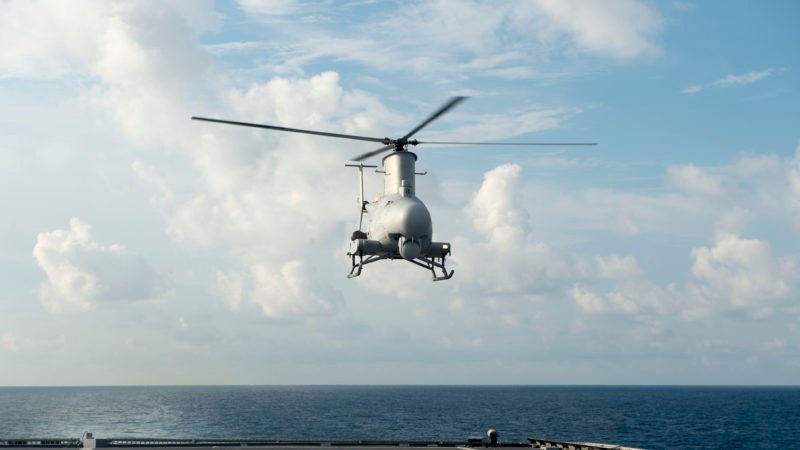How suitable are the Lethal Autonomous Weapon Systems (LAWS) for the Oceans?

AI and Naval warfare?
Autonomous weapon considered as the future for the Military industry. Over the past decade, the accelerated development of new technologies in warfare, specifically robotic weapons including unmanned drones and autonomous weapons systems (AWS) has introduced complex challenges and debates for Governments, Militaries, of course, Humanitarian Organisations. The development of AWS has serious implications for the future of warfare. The central issue remains the potential absence of human control over the significant technologies in identifying and attacking targets, whether it is a military or human target. There is an insight of profound displeasure with the idea of allowing machines to make life-and-death decisions in the war-zone with little or no human involvement.
Are they suitable for our Oceans?
Experts consider, that Huge water bodies are considered the most suitable area for the initial deployment of lethal autonomous weapons as identification of the target is easier, and there is a relatively smaller presence of Humans. Several ideas explore the possibilities of an armed AUV increasing the bandwidth at which any naval force operates, as vessels will have the capacity to engage enemy targets without human intervention or any input from the command team, however, this idea has been criticised at very first by the Humanitarian organisations, allowing a machine having a decision of life and death without any external inputs always termed as lethal.
Automated weapons – A holy grail for Navies?
The future of maritime security in this ‘automation revolution’ may well take the world to a system that will be at the helm of command and control of navies, with authorisation to deploy lethal autonomous weapons, when it considers it necessary, completely replacing human command teams patrolling the Oceans. The use of autonomous weapons brings an undeniable advantage in protecting maritime boundaries, with high exposure to submarines and other threats. For the navies, deploying lethal weapons will make supplementary sense for sub-surface missions, as targeting through Remotely Operated Vehicles is doubtful, with existing communications in submarines being limited to ELF (Extremely Low Frequency) and VLF (Very Low Frequency) due to the properties of radio waves in salty ocean water.
Debate and Complying with Geneva Convention
Conversely, the conformity of AI-based lethal autonomous weapons with humanitarian laws is a debate that has gathered global importance over the decade. If we use the ICRC favored definition, “‘autonomous weapons” as an umbrella term embracing any type of weapon with ‘autonomy’ in its “critical functions”, in other words, weapons that can intercept, detect, identify, track and destroy, damage, neutralize targets without any human intervention. UN- CCW, The United Nations Convention on Certain Conventional Weapons, which has been the forum for the discussions surrounding the legality of the lethal autonomous weapon system, has held multiple rounds of discussions on the legality of LAWS, but has failed to arrive at a common consensus on how these evolving weapon systems should be regulated. While the debate goes on, Governments and militaries around the world retain developing weapon systems with different levels of autonomy. It is likely, that before any UN-backed convention on the regulation of LAWS is agreed upon, there will already be in existence of weapon systems with critical function autonomy. Another, challenge in front of the UN policymakers is they can only check what governments and militaries want to reveal, any covert program undertaken by states for developing autonomous systems will remain outside the ambit of the regulatory committee.
Implications of LAWS in the Maritime Domain
The debates revolving LAWS is certain to increase in the upcoming years of technological advancements, and as more of these programs are executed and deployed, it is apparent that militaries may soon enter a stage of warfare in which autonomous weapons will be common in the maritime battle-space. Looking at the implications of using such systems, first will be institutional resistance from conventional navies and their personnel who will oppose any such autonomous system that seeks to replace them. The tasks that are to be carried out by autonomous naval combat systems are currently carried out by personnel on naval vessels or from ground stations on shores. There will be a necessity to acquire a new training curriculum among navies to produce technologically sound and personnel with adequate knowledge of Artificial Intelligence and above all governments which are equally proficient in testing and validating these new technologies. In the time that leads man-machine teaming in lethal skirmishes, navies all around need to indoctrinate their procedures, team, and practices with every plausibility, despite how remote they may seem after execution.
Conclusion
Maritime operations have been reconstructed with every period of development, and, as a new era of communication-centric warfare begins, naval experts and policymakers will accordingly need to account for all possibilities, left, right and center. Autonomous systems offer the possibility to go beyond what is human-limitations and gives Naval security projects a new zeal. However, keeping the debate centered to the disasters, which could be created by the use of LAWS, in the absence of human command and tiniest probability for any mishap is desirable in the era when machines are growing dominance over all forms of life on this planet.


















